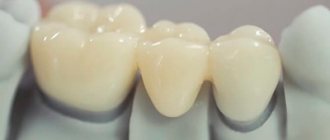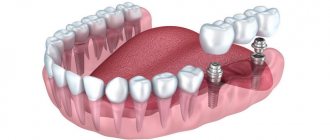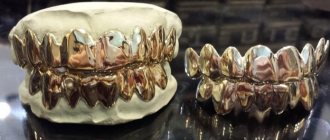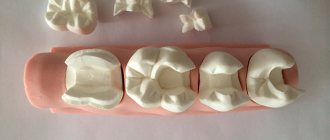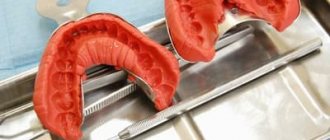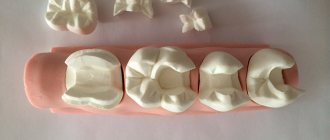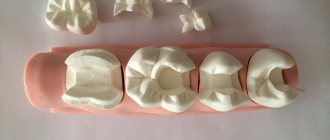Dental bridge - this is what people most often call dental bridges used by dentists to restore teeth when several units in a row are missing in a row. Dental bridges come in many different types, are made from different materials, and each type of structure has its own characteristics and advantages. Naturally, the price of different types of dental bridges will also differ.
In this article, we will tell you in detail about dental bridges: we will describe in detail the indications for their use, consider the types of dental bridges, the main characteristics, and also indicate approximate prices for production and installation in Moscow.
Indications for installation of dental bridges
Dental bridges are used to restore lost teeth, but not with single defects in the dentition, but when two, three or four teeth are missing. Bridges are applicable for the restoration of chewing and anterior dental units and effectively restore both the aesthetics of the dentition and all important functions of the teeth.
IMPORTANT: Installation of a dental bridge requires healthy supporting teeth. If the patient does not have strong teeth or has complete edentia (toothless jaw), the doctor may recommend either a removable denture or implantation followed by prosthetics with a conditionally removable orthopedic design. Implantation can be a good solution if the patient does not want to grind down healthy teeth for a bridge.
Price
- Primary appointment (examination, consultation) with a dentist (special offer) 100001
For free
Promotion
- Tooth restoration with a crown (E.max) 152013
21 900 ₽
- Tooth restoration with a full zirconium crown 152015
13 900 ₽
- Tooth restoration with an all-zirconium crown with ceramic lining 152016
21 900 ₽
- Tooth restoration with a metal-ceramic crown 152019
13 900 ₽
A bridge for 3 teeth is a non-removable orthopedic structure to restore the integrity of the dentition. When prosthetics are used, the anterior units are often made of solid ceramics, while the chewing ones are made of zirconium or metal-ceramics. The service life of the structure is 10-20 years, depending on the material from which it is made, as well as the health of the oral cavity and supporting teeth.
What a dental bridge looks like: description of design features
A dental bridge is a fixed prosthesis attached to supporting teeth and used to eliminate multiple edentia (the absence of several teeth in a row). The main elements of a dental bridge are artificial teeth and fasteners, with the help of which the prosthesis will be firmly fixed in the oral cavity.
Attachments for dental bridges can be in the form of:
Dental crowns placed on abutment teeth
Tabs
Clammers
Sometimes the design of a dental bridge also includes an additional element - a part designed to imitate a section of gum. Externally, the prosthesis resembles a bridge – that’s why it got its name.
The intermediate part of the dental bridge may have a different mechanism of connection with the soft tissues of the oral cavity:
- Flushing connection. In this case, a small space remains between the dental bridge and the soft tissues of the mouth, which ensures free passage of food under the denture, and therefore easier care for it;
- Tangent connection. With this type of connection, one side of the bridge will touch the gums, and such prostheses are especially relevant in the restoration of teeth included in the smile zone. They provide better aesthetics, are easy to use, and do not interfere with normal diction;
- Saddle-shaped. With this connection, the bridge connects to the soft tissues of the mouth as tightly as possible.
The type of dental bridge design is selected at the stage of planning prosthetics and together with the doctor leading the treatment!
Types of dental bridges
At the very beginning of the material, we mentioned that there are quite a large number of different types of dental bridges. The classification of bridges is carried out both according to the material of manufacture and the production technology.
Based on the first feature, the following types of dental bridges are distinguished:
Metal
Metal-ceramic
Ceramic
Zirconium
Plastic
Based on production technology, the following dental bridges are distinguished:
- Adhesive. It is most often used when only one tooth needs to be restored with a bridge. Such a prosthesis has a base - a fiberglass arch on which the artificial tooth is located;
- Stamped dental bridges are several dental crowns welded into a single structure;
- Cast dental bridges are the most durable denture option.
The material and manufacturing technology of a dental bridge will determine its cost and also its main performance characteristics, and below we will look at the main types of bridges, their features, pros and cons.
But first, let’s answer a question that patients often ask orthodontists – which is better, a dental bridge or implants?
Which is better - a dental bridge or an implant?
Here we need to make an important note - prosthetics can be carried out without implants, but implantation necessarily involves the stage of prosthetics. Of course, implantation of implants will increase the final cost of treatment, however, when installing a prosthesis on implants, you will not have to grind down healthy teeth, in addition, the dental bridge will be fixed as firmly as possible in the oral cavity and this increases the comfort of its use, as well as the useful life of the prosthesis.
But of course, the patient and the doctor must decide how to restore teeth in a specific clinical case. For example, if examination and diagnostics reveal absolute contraindications to implantation, then lost teeth will have to be restored using classic prosthetics and the installation of a dental bridge on the supporting teeth.
Installation steps
After choosing a patient and a doctor to install a metal-ceramic bridge on the teeth, I proceed to the steps:
- Diagnosis
and treatment of abutment teeth according to indications; - Grinding
the tops of the teeth to the thickness of the prosthesis (1.2-1.5 mm), if necessary, depulping. Since significant grinding may affect the nerve, it is removed; - An orthopedic doctor takes an impression
to make individual prostheses (this takes 7-14 days); - Trying on
the finished prosthesis; - Fixation
with dental cement.
The finished structure does not always stand up “like original”, then the doctor promptly “adjusts” it.
Metal dental bridges: pros, cons
Metal dental bridges can be called an outdated type of bridge prosthesis - they are almost never used in modern dental prosthetics, because the number of their disadvantages significantly outweighs the number of advantages. Dental bridges made of metals and their alloys are too heavy and bulky; their installation causes increased wear and tear on healthy teeth.
In addition, metal dental bridges are not highly aesthetic; when wearing them, a person may constantly feel an unpleasant and pronounced metallic taste in the mouth. The risk of an allergic reaction cannot be excluded. If we talk about the advantages of metal bridges, there are only two of them - maximum strength and low price. Of all types of metal dental bridges, solid dentures will have the highest reliability and durability.
Thanks to casting production technology, such dental bridges have a long service life and are able to flawlessly withstand constant and heavy loads. Dental bridges of this type are recommended for installation in patients with deformation of facial features caused by atrophy of the jaw bone tissue.
Metal dental bridges can be made from different metals and their alloys, including precious metals. Typically, the raw material for the production of metal dental bridges is cobalt-chrome alloy. But gold can also be used. Then the price of the prosthesis will increase, but neither its aesthetics nor the degree of comfort in use will improve. If prosthetics are carried out in the area of the front teeth, then dental bridges made of metal ceramics and ceramics can be a much more successful solution; if you need to restore chewing teeth, you can opt for the strongest bridges made of zirconium.
How much does a metal dental bridge cost? The answer to this question will depend on the technology of its production, as well as on the number of crowns in the structure, and the type of metal used to make the prosthesis. For example, if ordinary metal is used and a bridge is made for two dental units using casting technology, the cost of the prosthesis will range from 8 to 9 thousand rubles.
Plastic dental bridges
The main advantage of a plastic dental bridge is its low price. It seems attractive to many people who want to restore lost teeth. However, before making a choice in favor of a budget dental bridge made of plastic, it is worth considering its disadvantages. And there are quite a lot of them. Among the disadvantages of plastic bridges:
- Low aesthetics. Artificial teeth made of plastic do not have the same beautiful natural shine as natural human teeth;
- Fragility. Dental bridges made of plastic easily break and are damaged by stress, but they cannot be restored - the broken element will have to be replaced, which implies new costs for prosthetics;
- Risks of allergic reactions;
- Over time, a plastic bridge will lose its visual appeal, since the plastic can darken under the influence of various factors. In addition, plastic wears out quite quickly. On average, plastic dentures will have to be replaced every 3-5 years.
Due to the listed disadvantages of plastic bridges, it is better to initially plan more expensive prosthetics using dental bridges made of metal-ceramics, ceramics and zirconium.
Advantages and disadvantages of plastic crowns
- Good functionality.
The main objectives of temporary prosthetics are to protect the prepared tooth from the effects of the external environment and to give the patient the opportunity to chew food. Plastic crowns cope with these tasks. - Production in a short time.
You can install a plastic crown immediately or just a couple of hours after preparing the tooth. These designs are easy to manufacture, so the patient does not have to leave the clinic while waiting for the doctor or dental technician to finish working on the prosthesis. - Low price.
The cost of installing plastic crowns is much lower than products made from any other materials.
- Short service life.
Plastic is a soft material, quickly erased and stained by food coloring. Products with a metal frame will last longer, but over time the plastic layer needs to be changed, because it is almost impossible to bleach a plastic crown. - Porous structure.
The soft structure of plastic absorbs not only dye pigments, but also odors, and also becomes a favorable environment for the growth of bacteria. This is why patients with temporary dentures need to be especially careful about their hygiene. - Allergenicity.
Individual allergic reactions to plastic are possible.
Metal-ceramic dental bridges: optimal price-quality ratio
Metal-ceramic dentures are quite in demand among patients and this is not surprising, because they are not inferior in strength to metal dental bridges, but at the same time have a much more aesthetic appearance. A metal-ceramic bridge achieves high aesthetics due to the fact that its crowns are covered with a layer of ceramic mass. Layer-by-layer application of ceramics onto a metal base allows you to obtain artificial teeth with the same shade as healthy teeth.
IMPORTANT: Despite the good aesthetics, dentists do not recommend choosing metal-ceramic dental bridges for dental prosthetics in the smile area. The fact is that the metal base of such a prosthesis can be quite noticeably visible through the ceramics. To restore the front teeth, it is best to use metal-free dental bridges that have the most natural and aesthetic appearance.
A metal-ceramic dental bridge can be placed both on abutment teeth and on implants. The price of the bridge will depend on the manufacturing technology and the number of units being restored. The average cost of a metal-ceramic bridge for two dental units is 16,000 rubles.
Unfortunately, it is not always possible to place a metal-ceramic dental bridge on a patient. Bridges made from this material cannot be used if:
- Advanced periodontal diseases;
- For some malocclusion pathologies. If malocclusion is detected, orthodontic treatment is required before installing a metal-ceramic dental bridge;
- Low natural crown of teeth.
Contraindications to the installation of metal-ceramic bridges are identified at the first stage of prosthetics, during which the patient undergoes examination and diagnosis.
What are the advantages of the design?
Metal-ceramic dental bridges have important advantages, due to which they are chosen by the vast majority of orthopedic dentists’ patients. Let's take a closer look at the positive characteristics:
- high aesthetics combined with a relatively low cost: this is the main advantage of a metal-ceramic bridge, which often becomes the “factor of choice” for the patient,
- fast production,
- Possibility of installation on both natural teeth and dental implants,
- quick adaptation and easy care.
Only until 15.01 South Korean implant Osstem - from 18,500 rubles.
Hurry up to sign up for a free consultation and lock in promotional prices.
Call now or request a call
Opening hours: 24 hours a day - seven days a week
Ceramic dental bridges
Ceramic dental bridges are the best choice if you need to restore the front teeth that fall into the smile area. Dental ceramics is a material that has transparency and light transmission similar to natural tooth enamel, so dentures made from it have the most natural appearance; they are very difficult to distinguish from natural teeth. However, in terms of strength, ceramic bridges will, of course, be inferior to prostheses made of metal and metal-ceramics. The price for a ceramic bridge of 2 units is from 20 thousand rubles.
If, as a result of prosthetics, you want to get both high strength and aesthetics from the prosthesis, then it is worth considering the option of installing a dental bridge made of zirconium dioxide. This material has been used in dentistry relatively recently, and few patients have heard of it. Dental bridges made from high-quality zirconium dioxide are as attractive as ceramic products, and as reliable as metal structures. Moreover, zirconium is such a durable material that it can be used to make a bridge up to 6 dental units long! Another advantage of zirconium dental bridges is their durability - such a prosthesis can serve you flawlessly for 15-20 years! A zirconium bridge will cost more than a ceramic one - about 30,000 rubles per structure to restore 2 teeth.
IMPORTANT: The price of bridges will be influenced by production technology. The most modern technology for manufacturing dental bridges is CAD/CAM, which involves computer modeling of the prosthesis and its subsequent production using special milling equipment. The technology makes it possible to do without human intervention and, therefore, to avoid inaccuracies and errors. The finished prosthesis has high anatomical accuracy, which increases both the comfort of its use and the useful life of the dental bridge.
Adhesive dental bridges: what are they and when are they used?
Adhesive dental bridges can be attached to abutment teeth without first grinding them down. For this purpose, special beams, fiberglass tape or wing-shaped fasteners are used. Adhesive dental bridges are used exclusively for the restoration of anterior teeth, but they are not used to restore chewing units, because such prostheses do not have the required degree of strength.
The advantages of adhesive dental bridges include the following qualities:
- They allow you to carry out the restoration process as quickly as possible;
- They do not require depulping or preliminary grinding of healthy teeth;
- Such bridges have good aesthetics;
- An adhesive bridge does not require complex maintenance and can be easily restored if necessary;
- The price of prosthetics will be lower than when using bridges made of ceramics, metal-ceramics and zirconium.
However, adhesive dental bridges also have a significant number of disadvantages. In particular, it is worth knowing that they are not distinguished by either high strength or durability. On average, such a prosthesis will have to be changed every 3-4 years. In addition, with adhesive prosthetics, the artificial tooth is built up above the gum, which ultimately leads to atrophy of the jaw bone tissue in the area of the defect.
Concluding the review of the main types of dentures, let’s say that the choice of a specific type of denture should definitely be made together with your doctor. The specialist will take into account the particularities of the clinical case and contraindications and will be able to offer you those options for dental bridges that can solve your problem and suit you in terms of characteristics and price.
How dental bridges are installed: a detailed overview of the main stages of prosthetics
Dental bridge prosthetics begins with examination and diagnosis. This is a very important stage, as it allows you to eliminate possible contraindications, as well as select the optimal type of dental bridge for a particular patient. At the first stage of treatment, the doctor will examine the oral cavity, you will also be referred to an X-ray of the jaw, and may also be prescribed some general tests. Based on the information collected, a treatment plan is drawn up.
The further process of installing a dental bridge will involve the following steps:
1. Preparation of the oral cavity for prosthetics. In order for the installed dental bridge to last for a long time, it is extremely important that the patient’s mouth is free of diseased teeth, inflamed gums, tartar and plaque. Therefore, before prosthetics, it is necessary to treat caries, as well as sanitation of the oral cavity, during which the teeth are thoroughly cleaned of hard and soft dental deposits.
2. Next, teeth are prepared for the installation of a dental bridge. They are subjected to grinding and sometimes depulping.
Depulpation - this term in dentistry refers to the procedure for removing the dental nerve. Why is it needed before installing a dental bridge? The fact is that when grinding some teeth, there is a possibility of overheating of the pulp, which can lead to the development of pulpitis in the future. Therefore, sometimes a decision is made to pre-depulpate teeth before prosthetics with a dental bridge or crown.
3. The doctor takes impressions of the ground teeth, which are sent to the laboratory and where, based on them, first a computer model of the dental bridge is made, and then the prosthesis itself. When the prosthesis is ready, the patient is invited to try it on.
4. If during the fitting of the dental bridge no inaccuracies in its manufacture are revealed, the patient is satisfied with the prosthesis - it is fixed in the oral cavity using special dental cement. After installing a dental bridge, the dentist gives the patient detailed advice on caring for the oral cavity and dentures.
Bridge VS implant
It should be noted that among all possible options for fixed prosthetics, dental bridges undoubtedly occupy a leading position. But now the choice has become wider, and doctors definitely offer installation of implants for consideration.
Let us say right away that if prosthetics is possible without implantation, then the latter cannot do without the manufacture of prostheses. The implant is implanted into the bone tissue and is essentially an iron rod protruding from the gum. Therefore, a crown, dental bridge or removable denture must be placed on it.
There are very few disadvantages of implants, and they can only be called disadvantages conditionally. First of all, this is the high price of treatment, since it includes the installation of implants and the production of prostheses.
For reference: In the process of prosthetics according to the “implant + dental bridge” scheme, at least two doctors are involved - an implant surgeon and an orthopedist.
Another disadvantage of prosthetics on implants is the duration of treatment, if you do not take into account simultaneous or one-stage implantation. Classic surgery most often involves a bone graft or sinus lift, after which a break of several months is required. Only after osseointegration of the bone tissue is completed is it possible to install a dental bridge and other types of prostheses.
Pros of implantation:
- the integrity of the supporting teeth, since they do not need to be ground;
- reliability of fixation of titanium dental roots due to the strong “rooting” of the implant in the oral cavity;
- the comfort of using the bridge is comparable to using your own teeth;
- durability of prostheses, service life has no restrictions.
It is worth noting that implantation treatment has contraindications, although very few. However, if they are present, you will have to return to installing a dental bridge in the classical way or choose removable prosthetics.
Can complications occur after installing a dental bridge?
Complications after installing a dental bridge are possible and they can arise both due to the doctor’s mistakes and the patient’s fault, for example, due to failure to follow the recommendations of a specialist in caring for the oral cavity and prosthesis. The most common types of complications are:
1. Inflammation of periodontal tissues after the installation of a bridge. The inflammatory process may occur due to the fact that the bridge design was chosen incorrectly or the patient insisted on installing exactly this type of prosthesis. To avoid such a complication, you should listen to the opinion of a specialist when choosing a dental bridge for prosthetics!
2. Pain when chewing food. This phenomenon after the installation of a dental bridge occurs due to errors in the production of the prosthesis. If you notice discomfort when eating, and it does not go away within a few days, contact the clinic immediately. Inaccuracies in the manufacture of the prosthesis need to be corrected not only because such a bridge is inconvenient to use, but they can lead to rapid destruction of the supporting teeth.
3. Pain in the teeth under the crowns of the installed bridge. This complication can manifest itself due to poor oral hygiene and poor quality of the prosthesis. If the bridge was made with inaccuracies, the crowns will not fit tightly to the supporting teeth, which means that pathogenic microorganisms can easily get into them, which will cause caries and pain in the teeth. In this case, you definitely need to visit the dentist so that the doctor removes the denture and treats caries.
4. Development of pulpitis. This complication occurs when the supporting teeth are improperly prepared for the installation of a dental bridge. If, when grinding a tooth, the doctor allows its tissues and pulp to overheat, an inflammatory process may develop in the future.
These are not all the types of complications that can manifest themselves after installing a dental bridge if you do not follow the recommendations of your doctor or undergo treatment in a bad clinic that does not seek to treat patients, but to make money from them. Therefore, always carefully choose dentistry for your treatment!
What to do if the installed dental bridge begins to wobble?
If you suddenly feel that the dental bridge installed for you has begun to wobble, contact the dentist immediately! There are several reasons why this phenomenon may occur:
1. One or two supporting teeth are broken.
2. The composition used for the final fixation of the dental bridge in the oral cavity has deteriorated.
You cannot determine the reason why the dental bridge suddenly began to wobble on your own; you need professional diagnostics. When you come to the clinic, the doctor will conduct an examination and also prescribe an X-ray that will allow you to assess the condition of the supporting teeth and their roots and find out exactly why the dental bridge no longer holds firmly in the oral cavity.
In any case, to secure the dental bridge, it will have to be removed. There are no other ways to secure the structure in the oral cavity, and we strongly recommend that you do not follow advice from the Internet on securing dentures with glue and other compounds. This can lead to the most negative consequences - the development of a severe allergic reaction, inflammation and burns of the soft tissues of the oral cavity.
What to do if a dental bridge falls out?
There can be only one answer to this question - contact the dentist as soon as possible! A dental bridge may fall out due to the destruction of supporting teeth, due to the fact that its service life has expired.
You should not forget about the service life of a dental bridge; each type of denture has its own useful life, after which it is recommended to replace it with a new product. If you promptly monitor the condition of your dental bridge, as well as regularly undergo dental examinations and professional oral hygiene, you are guaranteed not to encounter the problem of the prosthesis falling out.
Types of bridge structures
Metal-ceramic bridges are only permanent (there are no temporary ones). These are permanent structures, i.e. The dentist fixes them, but the patient cannot (and should not) remove them. Crowns are usually attached to special cement, and when installed on implants, they can be fixed with small screws.
For a traditional bridge (metal-ceramic or any other), at least 1 abutment tooth is required on both sides of the empty space. But there are also cantilever bridges, which are fixed on 1-2 supports only on one side of the empty area. However, they often cause dislocation of the supporting tooth, so they are not recommended for installation. Adhesive prostheses, known as Maryland (Bonded) Bridge, are not made from metal ceramics.
There are also 2 methods of processing the lower part of supporting metal-ceramic crowns. In the classic version, a thin strip of metal remains under the gum, not covered with ceramics. But there is an even more “advanced” option - crowns on the shoulder mass, when the edges of the crowns in the area of contact with the gum and tooth stump are covered with a layer of ceramics. This eliminates the risk of allergies and does not cause “blueness” of the gums.
Free consultation on the cost of treatment in our dentistry
Leave a request and the clinic administrator will contact you within 15 minutes!
If such a nuisance does happen and your dental bridge falls out, do not delay your visit to the doctor. Grinded teeth are extremely vulnerable to the action of bacteria and an inflammatory process may occur, which will force the removal of diseased dental units. And whether it will be possible to build a bridge then is unknown. Because bridges require supporting teeth or must be placed on implants!
You should also urgently contact a dental clinic if the tooth under the bridge hurts or swelling appears on the gum above the installed denture. Self-medication will not help here, because all these signs indicate an inflammatory process in the supporting teeth, the development of which can only be stopped by professional treatment.
Care
No special care is required for a metal-ceramic bridge. Regular brushing with a toothbrush 2 times a day is enough: in the morning and in the evening with the toothpaste selected by the dentist. It is better to be careful with dental floss and use a special dental brush. It is worth paying attention to an irrigator and, if possible, purchasing one for more effective cleaning between teeth and crevices from food debris and plaque.
If you feel pain under the bridge during a hygiene procedure or at any other time, you should urgently visit a dental clinic. There may be secondary caries or an insufficiently cured and treated cavity.

